Art & Exhibitions
artnet Asks: Memphis Group Co-Founder Nathalie Du Pasquier
Love it or hate it, but Memphis is making a comeback.
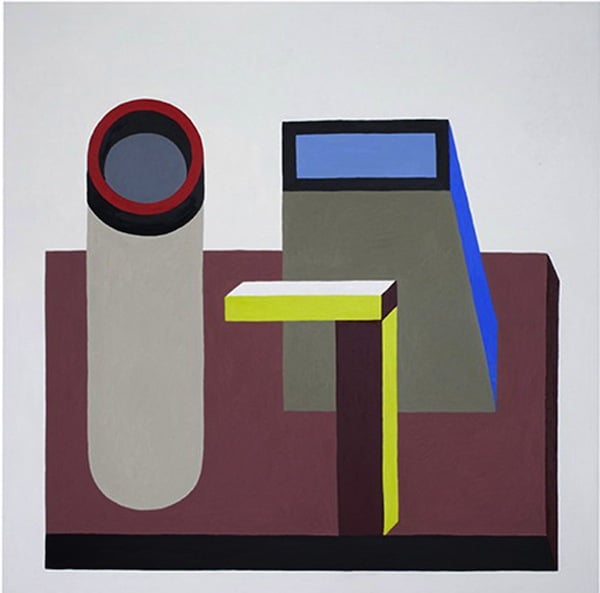
Photo: courtesy Nathalie du Pasquier
Love it or hate it, but Memphis is making a comeback.

Hili Perlson

Memphis, the 1980s phenomenon that disrupted the design world more than 35 years ago, is having a comeback. Sharp eyed connoisseurs would have noted signs of its return to the mainstream last year, with some original furniture classics now being reissued, and other aspects of Memphis’s bold eclecticism being cited by a younger generation of artists and designers.
The founding members of Memphis (the group was named after a Bob Dylan song), who gathered around Ettore Sottsass in Milan, tested the limits of graphic mash-ups mixing details, strong geometries, colors and, in an attempt to keep production affordable, clashing materials, never shunning synthetics like laminate and Formica. But the Po-Mo design that was all the rage during the better part of the early 1980s fell out of fashion as, during the 1990s, minimalism and streamlined objects were the dernier cri.
Though it always enjoyed a core of dedicated collectors, Memphis was once described as a “shotgun wedding between Bauhaus and Fisher-Price,” a coinage that aptly conveys the mixed emotions Memphis inspires. Now, signs of Memphis are popping up not only in furniture and textile design, but also in art.
artnet News met up with Memphis co-founding member Nathalie Du Pasquier at her studio in Milan, which occupies half a floor of an industrial building (the other half is used by George J. Sowden, another co-founder and Du Pasquier’s partner).
She discussed her current show in Berlin at Exile Gallery, which is also bringing a long-forgotten mural by du Pasquier to Basel’s Liste Fair next week.

Nathalie Du Pasquier Viva Pertini (1985).
Photo: courtesy Exile
Do you have any thoughts as to why Memphis might be enjoying a revived interest? Could it have to do with a new generation that’s exploring internet aesthetics and finding shared sensibilities with Memphis’s ideas?
Memphis was finished 30 years ago, and then for 25 years nobody talked about it. All of a sudden there is this kind of revival. I don’t know where it comes from. I think that things regularly come back, it’s not because internet aesthetics have anything to do with Memphis—I think they’requite different. When I was young there was a revival of the thirties … Things tend to just return sometimes.
Don’t you think that the eclecticism of Memphis could be striking a chord in an age where everything is accessible, again, via the internet?
Memphis existed before the internet, and all the ingredients of Memphis were things that were coming from a lot of different horizons. First of all, from the radical movements in Italy of the 1970s, but it also took things from all over the world, from the iconography of different countries, and of poor places as well, as Memphis sought to break hierarchies: between materials, yes, but also between influences. It was really breaking the rules of Modernism in that sense. Once the rules were broken, they have never been put back together, so what happened 35 years ago is still going on now—that’s why it’s not really revolutionary, this return of Memphis.
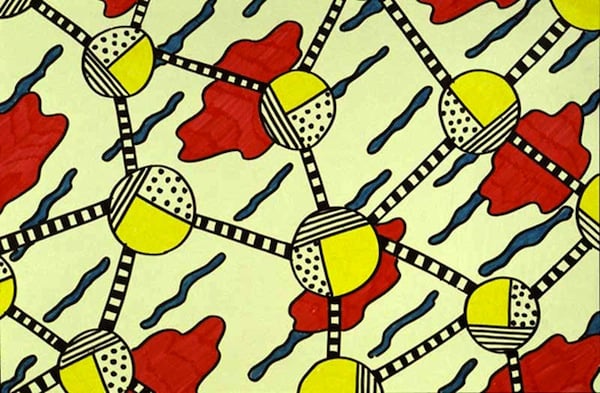
Nathalie du Pasquier, untitled textile design, 1982
Photo: courtesy Nathalie du Pasquier
What connected everyone in the group? How did you find each other?
It was very traditional and simple in the sense that it was all happening around Ettore Sottsass. He had been asked to do an exhibition, and he decided to call a lot of different people and do a very different kind of show. He was the leader and the engineer of all that. Also because a lot of the people who were founding members were much younger than him, or working in his studio. But Memphis was not a studio per se. We would meet, have dinners together, and then once a year we would have an exhibition that was chosen around an idea.

Nathalie Du Pasquier’s studio in Milan
Photo: Hili Perlson
So everyone was working independently?
Totally, yes, there was no studio. But the collection was built as a collection. Of course, every piece had the designer’s signature, but sometimes I must say it was not really obvious. Though the spirit was precisely that: to represent a great variety of influences that could be gathered together.
My first pieces, as I was designing surfaces, were combined with pieces by other people, in particular those of George J. Sowden, who’s also a founding members of Memphis and my boyfriend. He had designed some pieces and proposed that I’d do some surfaces, textiles, and silkscreen prints for his designs.
You’re showing a huge mural from the 1980s at the Liste art fair in Basel. It has quite a history, tell me about that.
George and I participated in an exhibition at the Louisiana, in Denmark, in 1985 that was called “Homo Decorans,” which was a kind of an anthropological exhibition about decoration, which was starting to be fashionable again after the years when Modernism had decided it was not so correct. Again, we were human beings like all the others, and we enjoyed decoration.
There was a rediscovery of the pleasure of covering surfaces, which was something Memphis had been doing, but also something a lot of other people were doing, also from other cultures. George and I were invited there to design a tower clock. So we went to Denmark and stayed in a little house they had by the beach, where they used to store the sailing boats. We built the tower in wood and covered it with several surfaces that we had brought from Italy, some plastic laminate, some cheap adhesive plastic, some parts I also painted.
Keith Haring was doing a mural at the entrance of the exhibition, and the other part of the entrance was empty, so they said: “Why don’t you do something there?,” and of course I said yes.
Normally, when you do these things, since they don’t pay you to do it, they destroy them when the show finishes. Haring’s mural was subsequently destroyed. But they were very kind and they could understand that maybe I would like to have mine. So when the show was finished they sent me the panels, which have stayed here on the wall of the courtyard ever since.
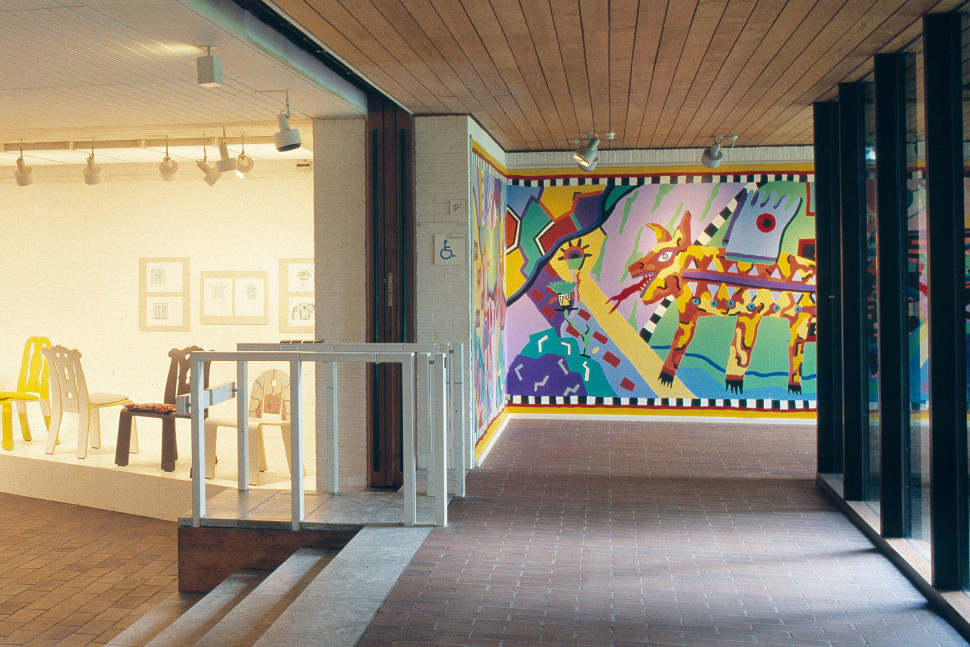
“Homo Decorans” installation view, with Nathalie Du Pasquier’s Viva Pertini (1985)
Photo: Courtesy Exile
At what point did Memphis fall out of favor?
It’s not a question of falling out of favor. I think the aim had been to break some things, and that goal was achieved in a year. We went on for five, six years. It also had to do with our idea of doing a particular type of design that could be produced and sold at a normal price—we were not interested in making expensive pieces. We would have liked to transform our ideas into products, I think, but of course that requires a huge amount of money that none of us had. So after a few years, all of us were doing our own things and Memphis was just one of them … But if you ask different members of the group, they would maybe tell you different things.
When did you transition from design to painting?
I realized after 1985-86 that I was not really interested in having a design studio, I wanted a different type of life. So I took a little room where I started to paint. Not having been shaped in any academy or formal schooling, or anything like that, I think I grew according to my nature. I think I realized that possibility that I had, and I enjoy that.
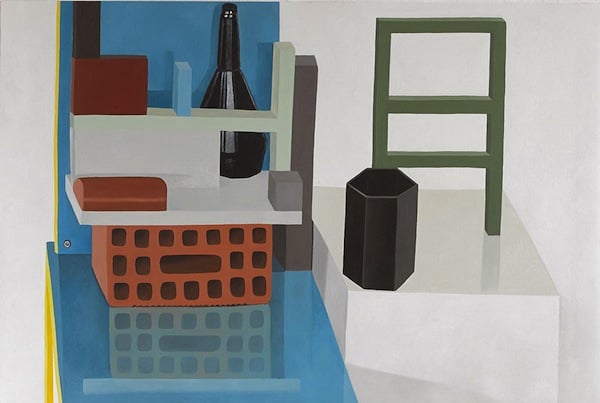
Nathalie du Pasquier, Untitled Painting (2015)
Photo: Courtesy Nathalie du Pasquier
In your paintings, too, you focus on surfaces, and deal with the two-dimensionality of three-dimensional things.
I started working and painting still lifes. I’m interested in the placing of things and the space between them and their representation. My work basically happens in two steps: I build the set, and then I copy precisely what I have on the set, without using a photo camera. So these are completely figurative paintings, even though they can look like something else. I’ve started keeping the models, sometimes showing them separately. I work big. I am always interested in working bigger than nature. Since recently, I am also working on kinds of trompe l’oeil, which are painted on paper and then cut out, they are like impossible objects flat on the wall. This is what you see in studio these days: a collection of objects.
The show in Berlin however is centered on your drawings.
I wanted to show works on paper and follow some threads within the 35 years of doing that. I gathered the early drawings for Memphis, for example. It’s interesting how, in the following years, some elements have kept reappearing or have been fundamental in my presentation of things.
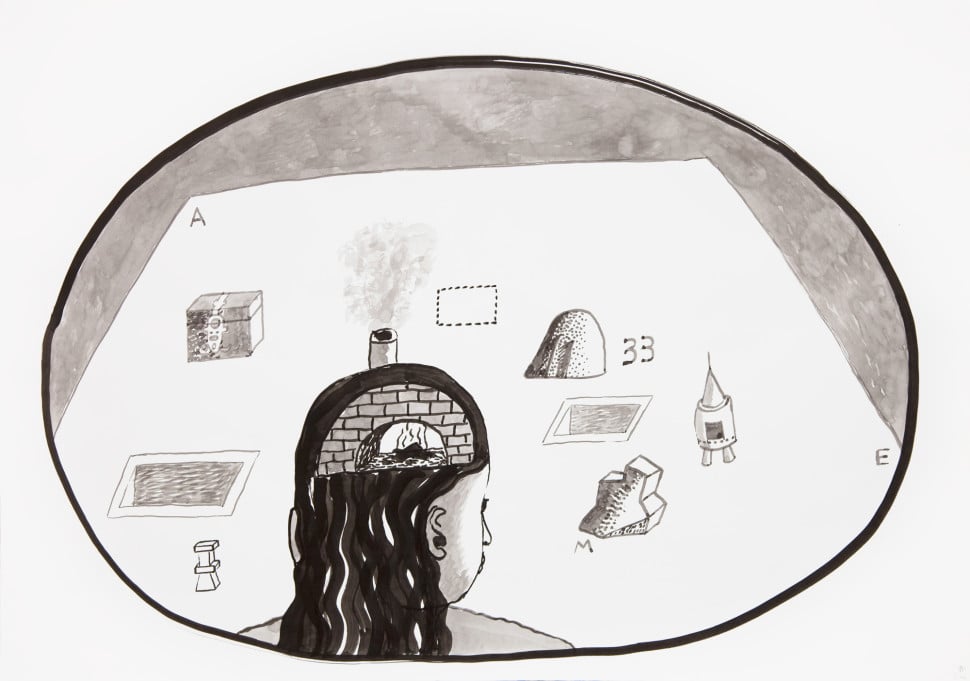
Nathalie Du Pasquier, The Big Game (2006)
Photo: Courtesy Exile
So it’s almost a retrospective, actually?
Yes, it ended up being a little like that, even though it’s only works on paper, and I have been mainly painting. The most interesting thing for me was to dig out all these drawings and try to figure out if something could have happened. Looking at them all together made me realize that there are in fact a lot of links. So that was interesting, because I had always thought that they were two separate worlds, and in the end it’s only me, it’s the same person.
But actually, I had already realized these things before, because last year I did a book about my 1980s drawings, together with my friend Omar Sosa.
What was the reason for publishing the book?
Omar does books, he’s the editor of the magazine Apartamento, and we wanted to do something together. He proposed the idea of the book. The idea was to do it as an object, not as an historical thing. I think it is quite a fresh document. We decided not to put any photos, only drawings, because, in the end, the drawings are where the spirit really is, very differently from the objects, especially when a person like me is not really a designer. So very often, when I was realizing things, they were out of scale, there were surprises …

Nathalie Du Pasquier, Untitled (1997)
Photo: Courtesy Exile
You also designed textiles for American Apparel recently. How did this collaboration come about?
Collaboration is a big word. They asked me to design some textiles and I did it. It didn’t take me very long, and then they made some clothes. As you said, on the internet, you can find anything you want. So one day, I received an email from this girl who’d found my website. I had no idea what American Apparel was.
Anyway, I did the drawings that we thought could form a collection. And then, it took them two years to do it. I also did some designs for Hay, a Danish interior company, as well. I was contacted by the British part of Hay, called Wrong for Hay, and they asked me to do some Memphis-style things. Last month, I went to Copenhagen to paint a mural in their shop.
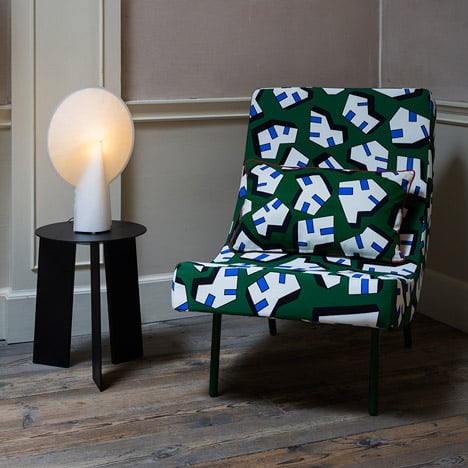
Nathalie Du Pasquier for Wrong for Hay.
Photo via: Dezeen